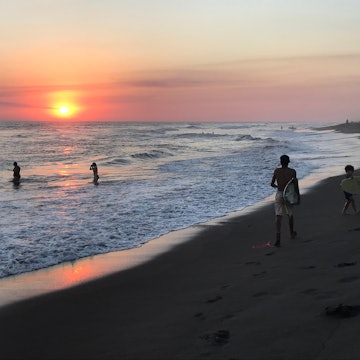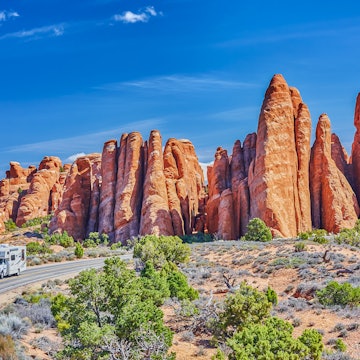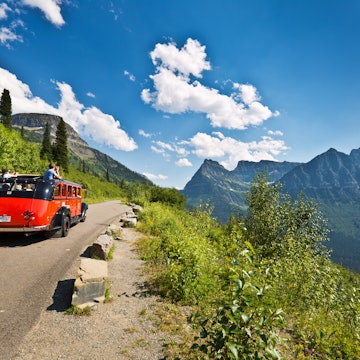
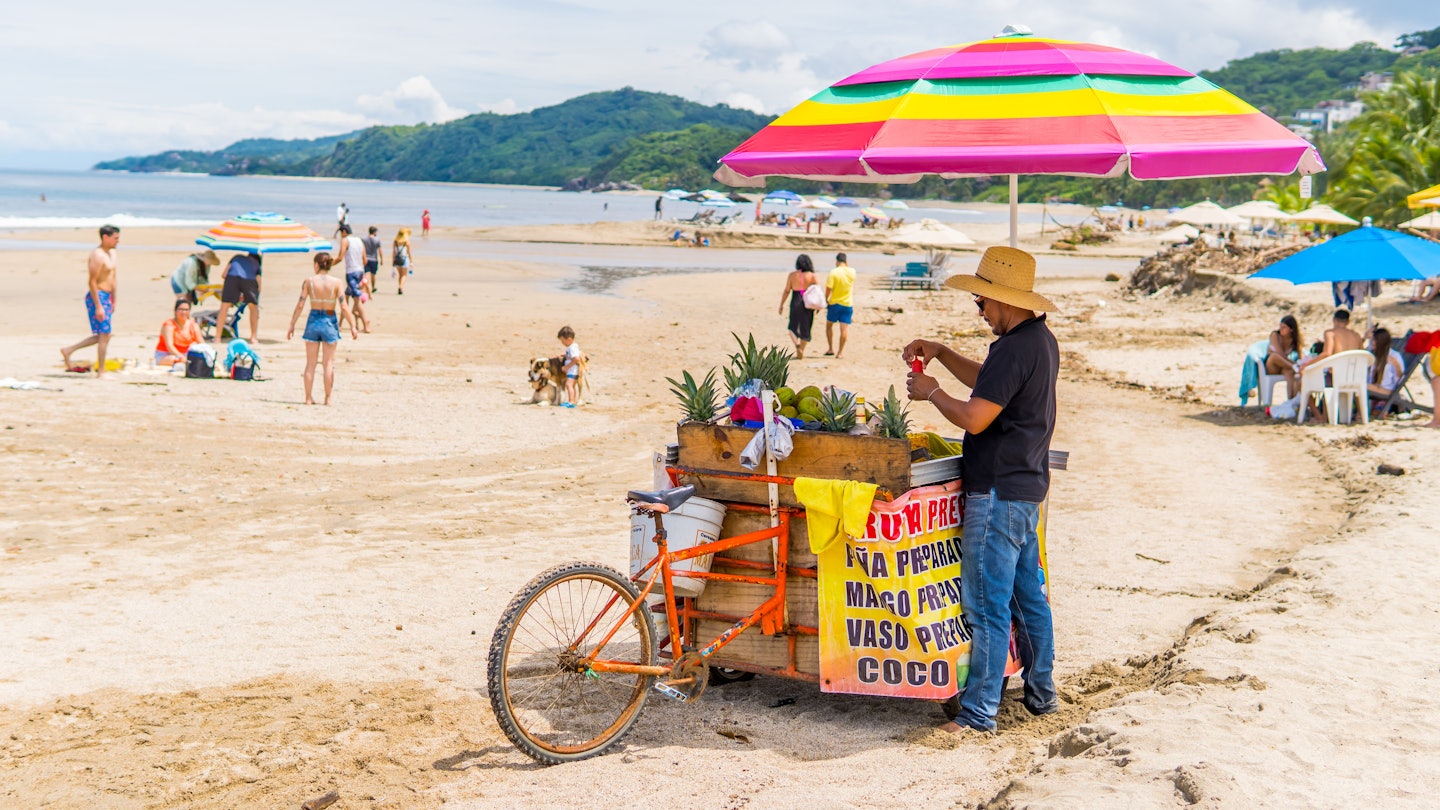
A man sells fruit on the beach in Sayulita. Roaming Pictures/Shutterstock
In a country rich with brochure-fodder coastline, the Riviera Nayarit stands out for its sunsets, surf and lackadaisical pace. Nayarit is the sand-in-your-toes, salt-in-your-hair, mezcal-in-hand sort of stuff – a place to start the day with yoga beside the waves and end it with tacos on the cobbled laneways of beautiful Pueblos Mágicos.
Along Mexico’s Pacific coast, the Riviera Nayarit stretches 320km (200 miles) from San Blas to the opening of the Bahía de Banderas (on which Puerto Vallarta lies). The headline acts are Punta Mita, a resort hub in the south, and Sayulita, arguably Mexico’s best place to learn to surf.
Between and beyond these two hubs, you can set out on hikes through thick coastal jungle, lie out secret beaches where you’ll be totally alone and enjoy wave-washed surf towns with some of the best sunsets in the Americas.
If you’re off to the Riviera Nayarit for the first time, here’s all you need to know.
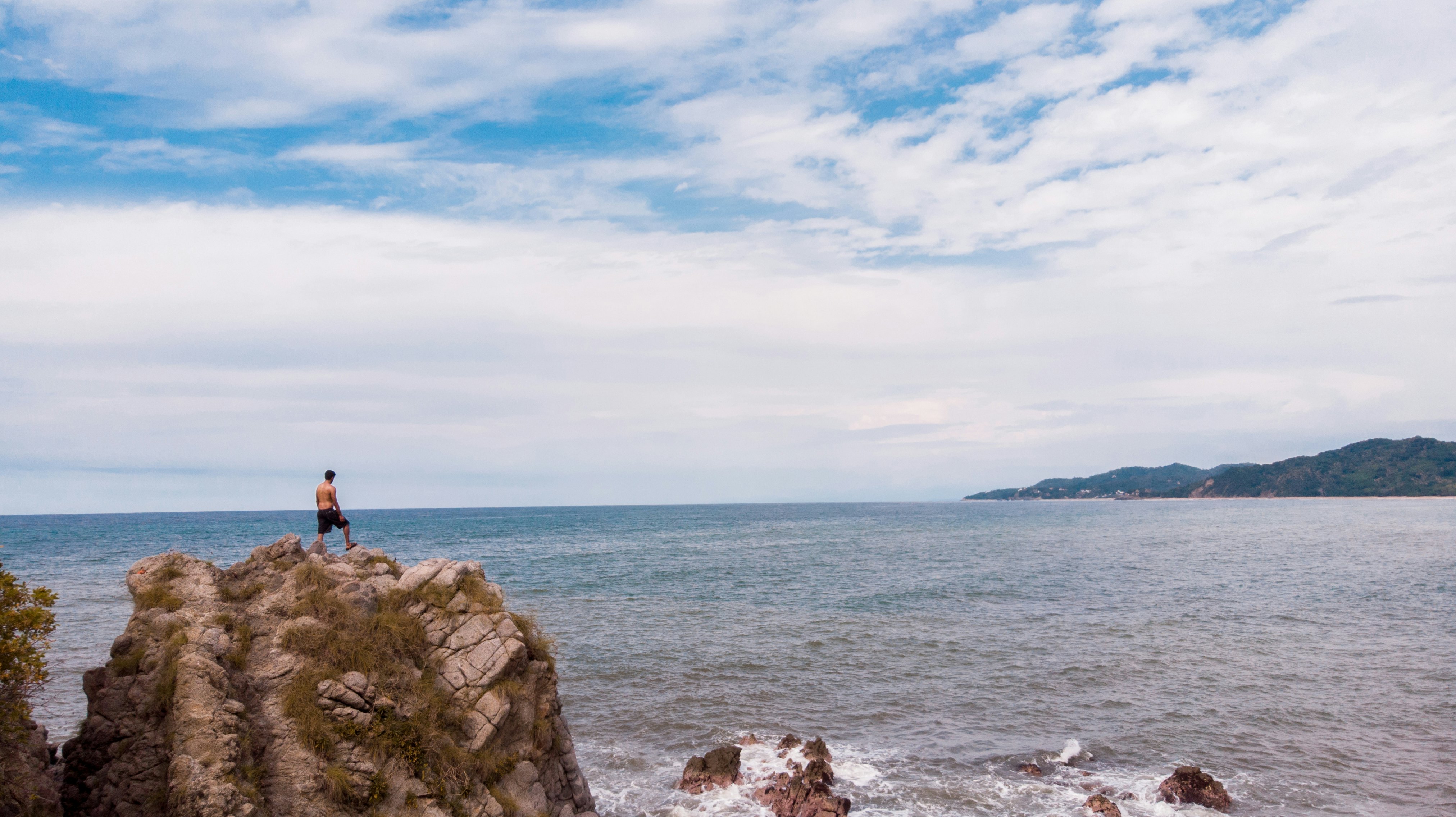
When should I go to the Riviera Nayarit?
The dry season is peak season in the Riviera Nayarit – for good reason. You can go weeks without seeing a speck of rain between November and March, and this season is more temperate than the summer months, with cooling ocean breezes rendering pretty much every day a perfect beach day. One caveat: the weeks around Christmas and New Year can get very busy in key resort towns like Sayulita and Punta Mita, as snowbirds escape the holiday cold for surf, sand and sea.
While the risks of soaring humidity and more rainfall in summer scares many potential travelers away, it’s still viable to visit in summer. True, it gets very balmy down here from June onward (and crowds pick up as summer vacations begin), and from August to October it can be hotter than a habanero salsa. So as long are you’re comfortable when it sizzles and pack vats of sunscreen, there’s still prime beach lazing to be had.
For surfers, summer is the best time as the big south-direction swells pulse up through the Pacific and light up all the breaks to max. This a great time to charge overhead conditions and hunt barrels. If you’re a beginner or an intermediate surfer, winter will work just fine, offering more mellow, manageable waves.

Is it easy to get in and around the Riviera Nayarit?
Puerto Vallarta is the gateway to the Riviera Nayarit; while the beach resort is technically in the state of Jalisco (the home of tequila), the Nayarit border is a stone’s throw north of the airport. Most people head to the beach towns up north right after touching down.
Both uner an hour’s drive from the airport, the resorts of Punta Mita and the surf town of Sayulita are the most accessible (hence their popularity). Expect a drive of at least 1½ hours to reach chilled Chacala, and more to access the remotest sands further north.
Uber, Didi and InDrive (the latter Mexican competitors to Uber) will work here – but cars can be in short supply, especially as you go farther north. When available, drivers are usually happy to run routes between the various surf towns and back to Puerto Vallarta. As a backup, use the local taxis, and agree on a price before you get in. White-painted buses head north to Compostela, stopping along Hwy 200 at San Pancho, Sayulita and Rincón de Guayabitos. Seats are cheap, departures are semi-regular and the buses are quite fun.

Top things to do in Riviera Nayarit
Chilling on the coast is the MO on the Riviera Nayarit – and there are more margarita-sloshing beach towns and come-laze-on-me coves than you could need for a week’s vacation. Yet peel yourself off the sand for a spell, and you’ll find shark-patrolled islands with hidden cave beaches, epic surf breaks and plenty more.
Boat over to the Marietas Islands
The stunning, UNESCO-listed Marietas Islands are a magnet for tourist boats. Now a national park, they lie 35km (22 miles) out to sea from the city of Puerto Vallarta; most day trips leave from Punta Mita. It’s wise to book onto an accredited tour because access to the pièce de resistance of the archipelago – the hidden crater beach of Playa del Amor – is now limited to 100 people at any one time. Snorkeling around the islands is also spectacular: jump in to see gnarled corals, kelp gardens and manta rays.
Hike the coastal jungles
Although the jungles that thread the riviera between Sayulita and Lo de Marcos look impenetrable, they are actually webbed with hiking trails. Since some paths are better maintained than others, and since various map apps love leading you down dead ends and non-existent trails, stick to the well-worn route that connects San Pancho to Sayulita. At 11km (7 miles) and with numerous paradise-like coves to explore along the way, this hike can easily take up a full day. Starting in San Pancho, you’ll go through forests of spiky ceiba trees draped in lianas. Later, the Pacific opens up in all its glory at a long, often-empty beach backed by ironwoods.

Surf on tropical breaks
The Riveira Nayarit is one of Mexico’s premier surf regions, with oodles of spots from Punta Mita up to San Blas. If you're a beginner, stick to the southern beaches and points: Sayulita is particularly well suited for learners, thanks to an abundance of surf schools and two very mellow waves right out front of the town for easy practice. The Punta Mita headland hosts a handful of surf spots that are better for intermediates, with the lovely A-frame wave at La Lancha offering lefts and rights over sugar-white sand.
Venturing northward to Lo de Marcos and Chacala can open up secret breaks – but they will be harder to reach, requiring local boat taxis or private surf guides. There’s surfing all year round here; summer is peak season, with winter better for improvers. One of the original and best-rated surf schools in the region, WildMex offers lessons in multiple towns, along with gear rental if you want to go it alone.
Venture north to Nayarit’s secret beaches
Sayulita, San Pancho and Punta Mita really do steal the limelight on the Riveira Nayarit. Yet since yet they make up just 48km (30 miles) of what's a 320km-long (200-mile-long) stretch of Pacific coast, you’d do well to get curious about what lurks further north. Things begin with a string of the most Zen surf towns you’ve ever seen. There’s mellow Lo de Marcos (what San Pancho was 15 years ago). There’s Los Ayala, a local favorite, with colorful fishing boats and equally colorful streets laden with taquerias. And there’s Chacala, home to petroglyphs that are 4000 years old. Keep heading north and even the towns drop away, as long, biscuit-tinted sands take over, sometimes broken up by a surf spot, other times by a palm-fringed lagoon.
My favorite thing to do in Riviera Nayarit
If I could retire tomorrow, I’d make a beeline straight for the super-chill surf-sand-sea town of San Pancho. It’s got everything: reliable waves, fantastic coffee shops and margaritas on tap come sunset.
Once, I spent a full month in San Pancho. I’d wake late to eat huevos rancheros while people-watching on the main cobbled street: a montage of rancheros on horseback, cold coconut sellers yelling “cocos frios!” and sunburned visitors like me. I’d then mosey down to the beach for the whole afternoon.
If you want, you’ll find some moderately challenging surf breaks. Yet my “secret” spot was the south end of the bay, where the cliffs get steeper and the waters get a bit calmer. That’s where I’d sit, reading between the sun-washed fishing boats and the villas only celebrities can afford, before walking back toward town for tequila cocktails at sunset.
It’s a routine I could get used to.
How much money do I need for Riviera Nayarit?
The Riviera Nayarit neither the cheapest nor the most expensive part of Mexico. The region is now very much on the tourist radar, and inflation (as everywhere) has bitten in recent years. You should also pay close attention to exchange rates before you plan your trip: the Mexican peso is volatile to the point where travel here was almost 25% more expensive in 2024 compared to 2023.
Still, North American and European travelers are likely to find prices palatable when shopping in supermarkets and eating out. Street food remains an absolute bargain – M$35 (US$2) is still enough for the tastiest cactus taco you’ve ever eaten, plus it gets you access to a salsa bar bursting with refried beans and habaneros.
The bulk of your budget will almost certainly go toward accommodation. Expect the usual story: beachside stays in boutique hotels won’t come cheap, while hostels located further back from the sands can be bargains.
Be sure to bring cash. Most big hotel resorts and many of the larger restaurants will accept card payments – but it’s cash only for tipping, as well as for street eats and a lot of souvenir shopping.
One night at a boutique hotel near Sayulita’s main beach: M$2900 (US$151)
Bus from Puerto Vallarta to Sayulita: M$65 ($3.40)
Two-hour beginner surf lesson: M$1450 ($76)
A cold beer (with a lime in it, of course) at a bar: M$40 ($2.10)
Espresso coffee at an artisan coffee spot: M$50 ($2.61)
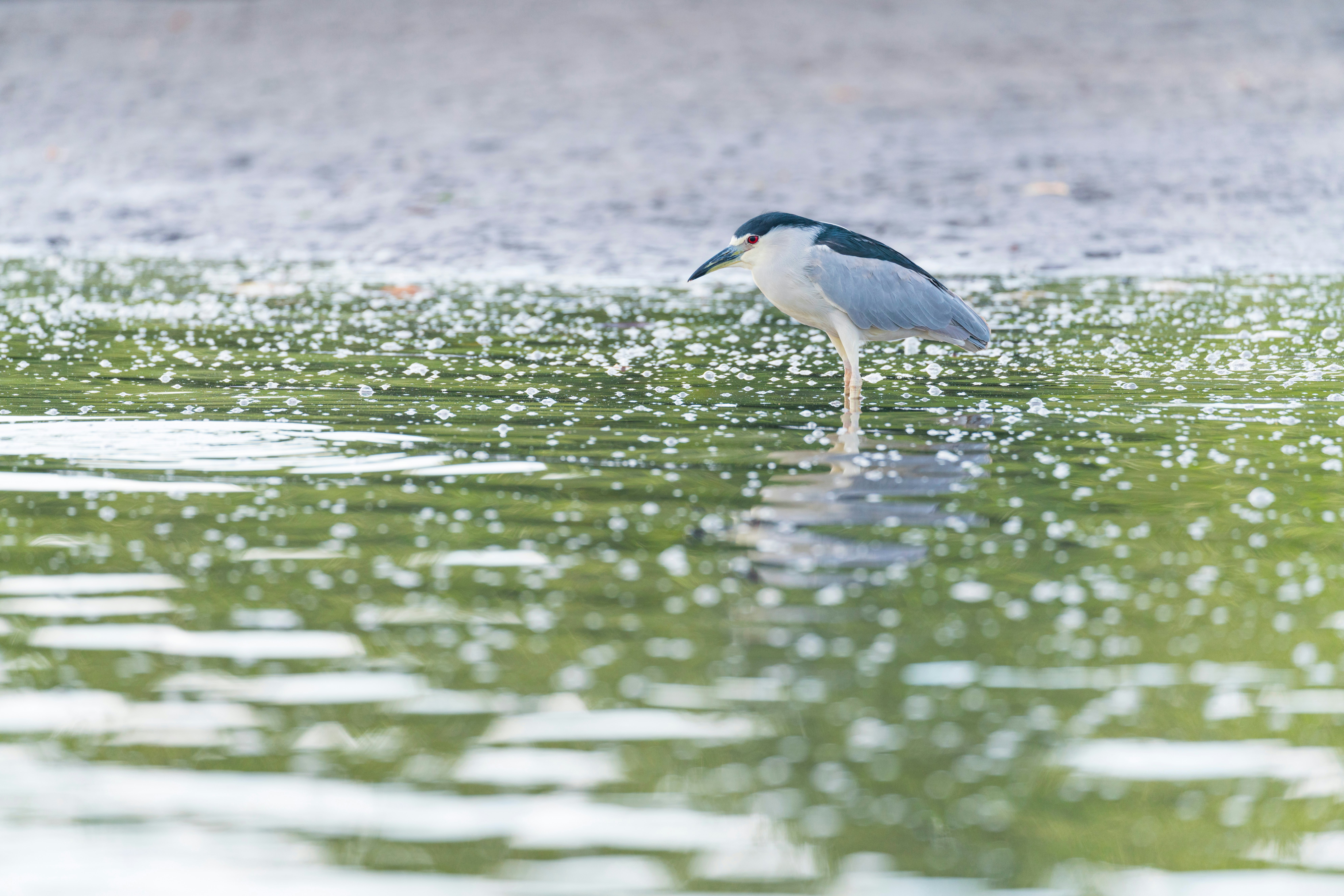
Respect the ocean along the Riviera Nayarit
The splendor of the ocean is the principal reason to visit the Riveira Nayarit: it’s always there, rolling up against the shores. But keep in mind that this is the Pacific – which means big currents and powerful waves, with swells especially punchy on certain stretches. San Pancho beach, Playa Chila and Playa Las Tortugas can get extra dumpy at low tides, which can be especially punishing for unseasoned surfers; stay attuned, too, to patches of reef hidden under the water. Swimming in shallow, protected spots where the locals are is often a good way to go.
Pack accordingly
Tempering ocean breezes aside, it’s always hot here and the sun is potent. Pack plenty of SPF for your face and body, a hat, and clothes that will keep you cool throughout the day. Still, because the Pacific is right on the doorstep, it’s not uncommon for evenings to get a touch chilly; a fleece or a light jacket should suffice. The wetter season (July to October) is also mosquito season: since it can be tricky to find good repellent in the local pharmacies, it’s wise to bring one in your luggage that you know works.










